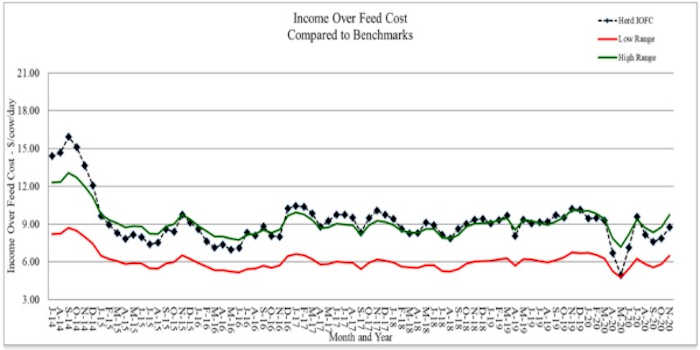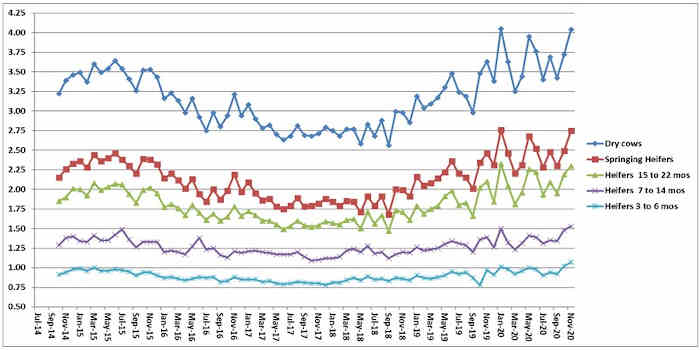By Virginia A. Ishler
Production perspective:
Precision feeding is an effective approach on dairy operations to reduce manure nutrients, specifically nitrogen and phosphorus, and minimize their environmental impact on water and air quality. With the 2025 goals looming on EPA’s Total Maximum Loads within the Chesapeake Bay Watershed, there is renewed interest in feed management. There have been a lot of positive changes in the past decade in ration formulation for protein and phosphorus levels. The challenge is crediting producers on a large scale that have implemented precision feeding to document nutrient reductions.
Many milk cooperatives include milk urea nitrogen (MUN) along with milk fat, milk protein and somatic cell count on each milk pick-up. This metric reflects the nitrogen status of the herd and the ideal range is between 8 to 12 mg/dl. With the inclusion of more corn silage and small grain silage in lactating cow diets, there has been a trend for an improved balance between carbohydrates and protein allowing for improved nitrogen efficiency.
Using data obtained from DHIA, Raleigh N.C. MUN trends were evaluated for years 2009 through 2019 with a more intensive evaluation of the last 5 years. The herds in the data set reflect slightly less than 10% of the Pennsylvania dairy herds. The trend showed a decline in MUNs. Results were within the recommended range of 8 to 12 mg/dl. In 2013 and 2014 MUNs spiked around 13 to 14 mg/dl. For the last 5 years MUNs averaged 11.26 mg/dl and the previous 6 years the average was 12.50 mg/dl. If the DHIA data could be extrapolated to the MUN data from milk cooperatives, this could demonstrate on a larger scale how much less nitrogen is being excreted into the environment, assuming a similar trend exists.
Monitoring phosphorus levels is not as simple. The best metric is to sample manure from the cow to illustrate the effect diet had on excretion. Sampling manure storage has its limitations, especially if it is not adequately agitated and/or if there is a lot of bedding or other waste included that could inflate phosphorus levels. Another way to document reduced phosphorus intake is to monitor dry matter intake and sample the TMR. Table 1 shows results from the crops to cow project where 26 herds were monitored for precision feeding. Using the 2001 NRC requirements for dairy cattle, an acceptable level of phosphorus intake is between 100-110% of requirement. Dry matter intake appears to be the driver for whether herds are meeting that metric. Even though there were only three herds averaging less than 70 pounds of milk, they do show the impact of efficiency on nutrient intake as a percent of requirement. The phosphorus percentages in the rations were reasonable; it was the high dry matter intake for the level of production that caused the elevated phosphorus intake.
Nutritionists have adjusted their ration approaches for protein and phosphorus based on many conversations over the years about the benefits to the environment, to animal performance and to improved profitability. The bottleneck is not the percent phosphorus being formulated, but less than ideal feed efficiency, which in the crops to cow project appears to be on production less than 70 pounds. Forage quality and energy balance could be factors creating this problem. However, as important as monitoring dry matter intake is for decision making regarding ration adjustments, this management practice is still very elusive. Implementing good feeding management practices by producers is going to be the platinum standard to reduce nutrient outputs. Many dairy producers have already implemented precision feeding and are reaping the financial and environmental benefits. There is still opportunity in the industry for improvement and monitoring dry matter intake routinely would be a big step in the right direction.
Table 1. Phosphorus intake on 26 dairy farms sampled from 2016 through 20181.

1The Impact of Corn Silage Harvesting and Feeding Decisions on Income Over Feed Costs (Ishler, Goodling, & Beck, 2018). SARE project "The impact of corn silage harvesting and feeding decisions on income over feed costs". Results are from two to four sampling periods per farm during this period.
2Milk production reflects bulk tank weights on day of TMR sampling.
3Dry matter intake reflects batch weights fed, cow numbers, refusals and TMR dry matter percent on day of sampling.
4Phosphorus percent from TMR analysis.
Note: ECM=energy corrected milk; DMI=dry matter intake; P=phosphorus
Economic perspective:
Monitoring must include an economic component to determine if a management strategy is working or not. For the lactating cows, income over feed cost is a good way to check that feed costs are in line for the level of milk production. Starting with July 2014’s milk price, income over feed cost was calculated using average intake and production for the last six years from the Penn State dairy herd. The ration contained 63% forage consisting of corn silage, haylage and hay. The concentrate portion included corn grain, candy meal, sugar, canola meal, roasted soybeans, Optigen and a mineral vitamin mix. All market prices were used.
Also included are the feed costs for dry cows, springing heifers, pregnant heifers, and growing heifers. The rations reflect what has been fed to these animal groups at the Penn State dairy herd. All market prices were used.
Income over feed cost using standardized rations and production data from the Penn State dairy herd.

Note: November’s Penn State milk price: $19.51/cwt; feed cost/cow: $7.43; average milk production: 83 lbs.
Feed cost/non-lactating animal/day.

Source : psu.edu